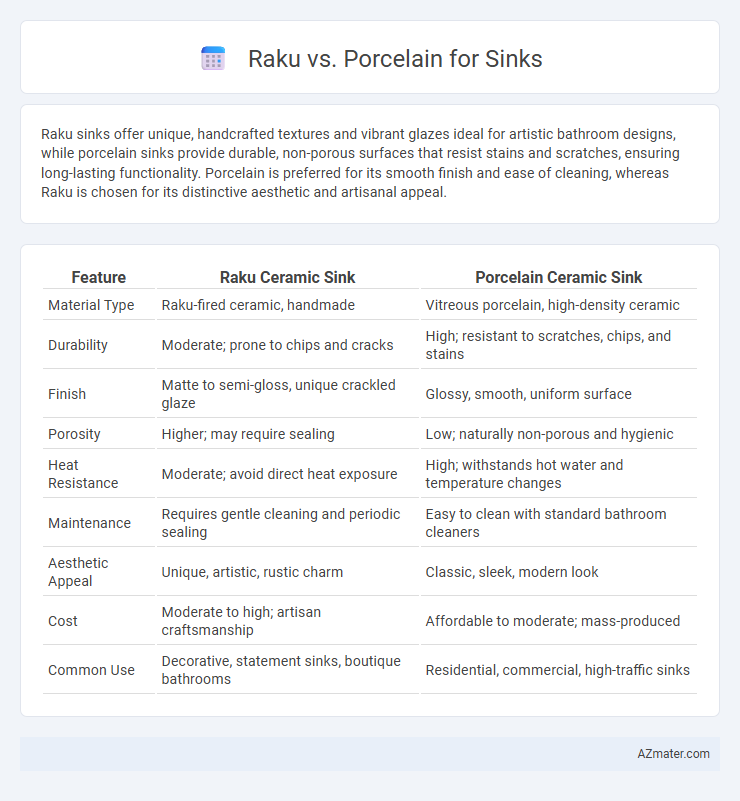Raku sinks offer unique, handcrafted textures and vibrant glazes ideal for artistic bathroom designs, while porcelain sinks provide durable, non-porous surfaces that resist stains and scratches, ensuring long-lasting functionality. Porcelain is preferred for its smooth finish and ease of cleaning, whereas Raku is chosen for its distinctive aesthetic and artisanal appeal.
Table of Comparison
| Feature | Raku Ceramic Sink | Porcelain Ceramic Sink |
|---|---|---|
| Material Type | Raku-fired ceramic, handmade | Vitreous porcelain, high-density ceramic |
| Durability | Moderate; prone to chips and cracks | High; resistant to scratches, chips, and stains |
| Finish | Matte to semi-gloss, unique crackled glaze | Glossy, smooth, uniform surface |
| Porosity | Higher; may require sealing | Low; naturally non-porous and hygienic |
| Heat Resistance | Moderate; avoid direct heat exposure | High; withstands hot water and temperature changes |
| Maintenance | Requires gentle cleaning and periodic sealing | Easy to clean with standard bathroom cleaners |
| Aesthetic Appeal | Unique, artistic, rustic charm | Classic, sleek, modern look |
| Cost | Moderate to high; artisan craftsmanship | Affordable to moderate; mass-produced |
| Common Use | Decorative, statement sinks, boutique bathrooms | Residential, commercial, high-traffic sinks |
Introduction to Raku and Porcelain Sinks
Raku sinks are handcrafted using a traditional Japanese firing technique that produces unique, crackled textures and vibrant, earthy colors, making each piece one-of-a-kind and ideal for artistic bathroom designs. Porcelain sinks, made from vitrified ceramic coated with a smooth, glossy glaze, offer durability, stain resistance, and a timeless white finish that suits classic and contemporary interiors. Choosing between Raku and porcelain depends on whether the priority is distinctive artistic appeal or sleek, low-maintenance functionality.
Material Composition and Origins
Raku sinks are crafted from traditional Japanese ceramic clay fired at lower temperatures, resulting in a porous, hand-textured surface that emphasizes natural, organic aesthetics. Porcelain sinks, made from vitrified kaolin clay fired at higher temperatures, offer a dense, smooth, and highly durable finish resistant to stains and scratches. The material composition of Raku emphasizes artisanal uniqueness and subtle imperfections, while porcelain prioritizes uniformity and long-lasting structural integrity.
Manufacturing Processes Compared
Raku sinks undergo a unique ceramic firing process involving rapid temperature changes that create crackled glaze effects, resulting in distinct aesthetics but requiring careful handling due to potential fragility. Porcelain sinks are manufactured through high-temperature kiln firing of vitreous china, producing a dense, durable surface that resists chipping and staining, making them highly practical for daily use. The contrasting manufacturing methods directly influence the sinks' durability, maintenance, and visual appeal, with Raku prized for artistic uniqueness and porcelain valued for long-lasting functionality.
Durability and Longevity
Raku sinks offer unique artisanal beauty but are less durable due to their porous nature and susceptibility to cracking under thermal shock, making them less ideal for heavy daily use. Porcelain sinks provide superior durability and longevity, resisting stains, scratches, and impact, which ensures consistent performance in both residential and commercial settings. Choosing porcelain maximizes lifespan and reduces maintenance, while Raku requires careful handling to preserve its aesthetic appeal.
Surface Finish and Aesthetics
Raku sinks showcase a unique, hand-crafted surface finish characterized by crackled glaze and metallic sheens, offering an artistic and rustic aesthetic ideal for statement pieces. Porcelain sinks feature a smooth, glossy surface with a pristine, clean look that complements traditional or modern bathroom styles. The tactile contrast between Raku's textured finish and Porcelain's sleek glaze defines their distinct visual appeal and durability in domestic environments.
Water and Stain Resistance
Raku sinks generally offer moderate water resistance due to their porous ceramic structure, requiring sealing to prevent water damage and staining. Porcelain sinks feature a dense, glazed surface that provides superior water and stain resistance, making them more durable for high-moisture environments. The non-porous nature of porcelain minimizes absorption, ensuring long-lasting protection against discoloration and water damage.
Maintenance and Cleaning Requirements
Raku sinks require delicate handling due to their porous surface, making them prone to staining and requiring regular sealing to maintain durability and appearance. Porcelain sinks offer a smoother, non-porous finish that resists stains and is easier to clean with standard household cleaners, reducing maintenance effort. While Raku demands more attentive care, porcelain provides a low-maintenance option preferred in high-use environments due to its resilience and simple upkeep.
Cost Analysis: Raku vs Porcelain
Raku sinks typically cost more than porcelain sinks due to their handcrafted nature and unique artistic designs, often ranging from $300 to $700 compared to porcelain's average price of $150 to $400. Porcelain sinks offer a more budget-friendly option with widespread availability and lower manufacturing costs, making them ideal for cost-conscious homeowners. However, Raku sinks provide distinct aesthetic value and potential investment appeal that can justify their higher price point in luxury or custom bathroom settings.
Environmental Impact and Sustainability
Raku sinks, crafted through a traditional Japanese firing process, often use natural materials and low-energy kilns, reducing their environmental footprint compared to porcelain sinks that typically require high-temperature industrial firing. Porcelain sinks, while durable, involve significant energy consumption and contribute to higher greenhouse gas emissions during manufacturing. Choosing Raku enhances sustainability by supporting artisanal production methods and minimizing resource-intensive processes common in mass-produced porcelain sinks.
Which Sink Material is Right for You?
Raku sinks offer a unique, artisanal look with handcrafted glazing that provides a warm, textured aesthetic, ideal for rustic or eclectic kitchen designs. Porcelain sinks, made from vitrified clay, deliver a smooth, durable surface resistant to stains and scratches, making them a practical choice for high-traffic kitchens requiring easy maintenance. Choosing between Raku and porcelain depends on your preference for design distinctiveness versus long-term durability and ease of cleaning.

Infographic: Raku vs Porcelain for Sink
 azmater.com
azmater.com